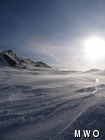In today’s observer comment, one intern explores why he has to shovel even when it doesn’t snow.
2012-02-11 17:34:58.000 – Brian Fitzgerald, Summit Intern
Snow being transported across the summit.
As the summit intern and executive snow shoveler I often ask myself, ‘Where did all of this snow come from? It hasn’t even snowed!’ Just the other week we actually did receive a few inches of snow and much to my surprise I found a few feet of drifted snow in front of the summit building out of the wind. There may not be an overwhelming amount of snow on the summit, but what snow does exist, you’ll find it’s doing interesting things. In the wooded hillsides of Mount Washington you will likely find snow in varying but mostly consistent levels as you move about, but up here above the tree line there is little to hold snow in place. Without trees light fluffy snow is at the mercy of the winds, and as is often the case, it gets moved around quite a bit. If you’ve ever seen snow in Tuckerman’s Ravine in June or July (or later) you probably already know what I’m talking about.On a hike around the summit cone I had the opportunity to saunter about the open snowfields and study (or struggle through) the varying depths and densities of snow. Some of my steps found hard crust that would hold my weight, and other times I would simply punch right through to a softer powdery layer. Sometimes there was a foot of solid powdery drift sitting right on the surface, while other times I found myself walking on exposed rock and ice. It turns out that on the same day down in Tuckerman’s Ravine, snow rangers for the White Mountain National Forest found 5 different and distinct crust layers in just 1.4 meters of snow depth. To back up just a bit, consider how those layers were formed. Certainly you can recall a lot of warm winter days in our region, followed by some fairly cold days and days where it snowed or perhaps when the sun shone all day. Just like rocks, snow can undergo metamorphism over the course of the winter as variables like temperature, humidity and pressure act on it. So to be blunt, why should be care about any of this? For all those backcountry adventurers who plan to venture above tree-line it’s extremely important for everyone to understand how to read snow conditions. Avalanches, caused by snow sliding off unstable lower levels of snow, are a serious danger for anyone venturing on Mount Washington, especially in Tuckerman and Huntington’s Ravine where avalanches have seriously injured or claimed the lives of many inexperienced and experienced backcountry travelers. That’s not to say you shouldn’t travel above tree-line in winter, but it’s certainly a good idea to take an avalanche safety course through any number of local outdoor organizations. And for daily avalanche forcecasts, snow reports or information on the ravines on the rockpile, visit the US Forest Service’s Mount Washington Avalanche Center at www.mountwashingtonavalanchecenter.org and as always be sure to visit the MWOBS’ site for conditions and forecasts before heading into the woods at www.mountwashington.org .
Brian Fitzgerald, Summit Intern
Team Flags Return for Seek the Peak’s 25th Anniversary
Team Flags Return for Seek the Peak's 25th Anniversary By MWOBS Staff Mount Washington Observatory is looking forward to continuing a much-loved tradition for Seek the Peak’s 25th Anniversary: Team flags. In inviting teams
Meet Summer Interns Zakiya, Max and Maddie
Meet Summer Interns Zakiya, Max and Maddie By MWOBS Staff We are excited to welcome six teammates to the summit of Mount Washington this summer! During their internship, these students and graduates will play
Saying Goodbye to the Summit
Saying Goodbye to the Summit By Alexis George After an extraordinary last three years working as a Weather Observer and Meteorologist, I am excited to pursue a different career. As sad I as am






